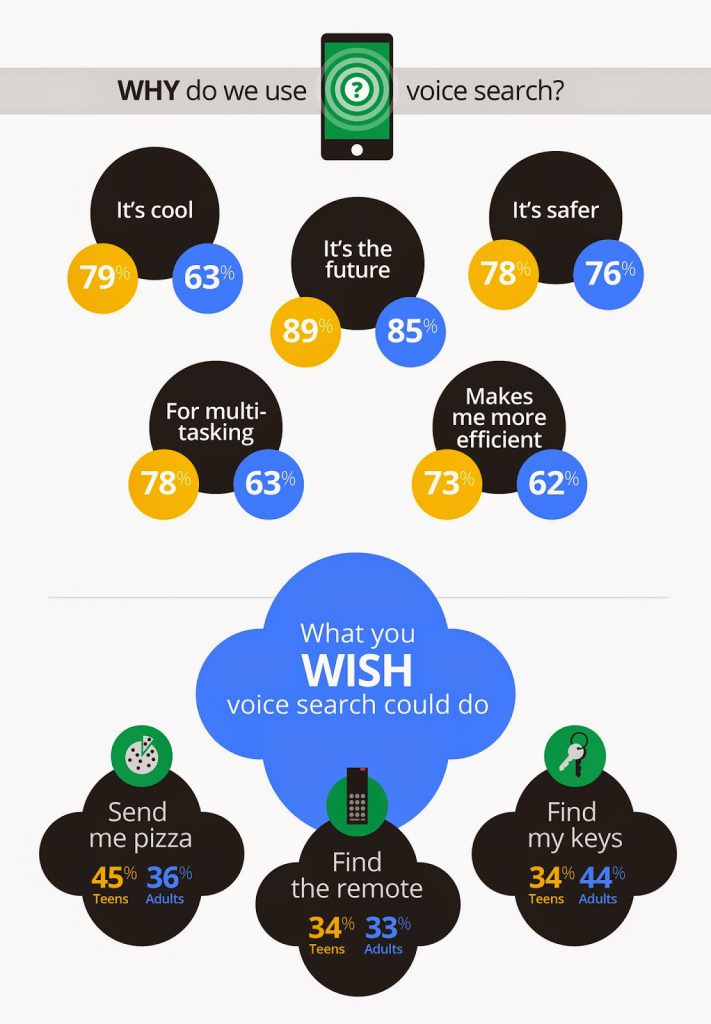When it comes to e-commerce (and especially to mobile commerce), every other week new trends and buzzwords rise and fall through your newsfeed. Lately terms such as “voice search,” “conversational commerce” and “virtual assisted shopping” have been appearing more frequently. These get pushed by mobile personal assistance operators by the likes of Apple, Google and Microsoft as well as Facebook and other social networks. And when those companies compete over a topic – you know that something’s going on.
In this two-part blog series we will give you an overview on what you should know as an online marketer in the e-commerce field, how to adapt to the new mobile user behaviors like voice search and a future outlook on conversational commerce.
- Part 1: The rise of voice search and how to adapt as an e-commerce business
- Part 2: How conversational commerce could change the e-commerce industry
In a hurry? Here’s a sum-up:
Mobile devices are changing the way we shop – not just on mobile but in fact on all devices. How’s that? The voice search function on mobile has gotten shoppers warmed up to artificial personal assistants. With voice search people are more likely to formulate their search query in a more natural, spoken language, with more context included. To match this behavior, companies have started using smart conversational technologies (2-way communication) across devices. This forms part of a new industry trend called “conversational commerce.” It’s all about making shopping more convenient and personal with the help of artificial intelligence. Virtual assisted shopping with chatbots and customer support via chat apps are some of the first examples of that adaption.
Sounds interesting, right? Now for the specifics:
The rise of voice search and how to adapt as an e-commerce business
Nowadays, mobile devices (particularly smartphones) play a major role in consumers’ lives, as they have become the default medium to access the Internet. Smartphone users not only access the internet for information or to socialize but 4 out of 5 American consumers now shop on their smartphones. Mobile usage is growing worldwide and so is mobile shopping. Nevermind to thrive, in order to simply survive, e-commerce marketers have to reach their audience on mobile devices and deliver a satisfying mobile experience. To do so they have to understand how smartphones are used differently compared to desktop devices. The use of voice search through mobile personal assistants is probably the most prominent characteristic, as there is no equivalent on desktop devices.
How voice search is used thus far
Even though Siri has been available for iPhones since 2011 and Android Now since 2012 (Windows Cortana followed 2015), mobile users just started to warm up to voice recognition tools for searching the web. One reason for that is that until recently the speech recognition error rate was too high. According to Google, in the last two years the rate has dropped from over 20% to 8%.
The 2014 Google Mobile Voice Study found that especially teenagers have adapted to voice search. Already 55% of teenagers owning a smartphone use voice search several times a day, while only 41% of adults use voice search at least once a day. Another report in 2014 by Thrive Analytics revealed that 71% of US smartphone users aged 18-29 and 59% aged 30-43 use personal assistants that enable voice search.

Both reports suggest that teens and adults alike use voice search because it’s cool, easier, more efficient and it saves them time. So far users mostly use voice commands to control their mobile devices (ask for directions, to call someone, etc.) or for basic searches (weather, help with homework, etc.). When it comes to shopping, however, consumers want better services from their personal virtual assistants, such as deal notifications and shopping habit recognition, or seamless ordering and purchasing.
A lot has happened since 2014 and it’s time we look at how voice search developed both technically and in usage, and how these developments impact e-commerce businesses.
You might think the biggest difference is the search query length – it’s not…necessarily
Everybody expects that the query length must be longer with voice searches because of specific articulated questions. That has only partly proved to be true.
On the one hand, Microsoft researched the use of Cortana and revealed that users are more likely to search for longer queries in spoken searches vs. written ones. Google Webmaster Trends Analyst John Mueller also said in a recent Google Hangout that many of the voice searches are done in much longer-form sentences.
But analysts and marketers who analyzed their voice search queries see little change in overall query length over the past two years. It’s possible that the data source and analytics tools don’t yet cover voice search to its full potential (Google has announced to introduce a new voice search tool to Google Analytics this year). Another possible reason is how different generations use their smartphones. The younger generation uses “unnatural” speech when they interact with search engines, using only the most important keywords, while the older generation uses more natural speech and poses more complex questions. The best example is the viral story of the granny that politely asked Google to translate something and the reactions on that story by teenagers.

Voice searches are phrased - or “asked” - differently and are often context related
Aside from the length, there are other ways in which search queries differ between typed and voice operated. As mentioned, personal assistants on mobile devices lead to a more natural language being used. Searches are more often phrased as a question (“Productsup headquarter” vs. “Where is the Productsup headquarter”) - and questions reveal a clear intent (what, who, when, where). Interestingly, mobile voice search is three times more likely to be local-based than text search. This means questions often include a local context (concerts near me, best outfit for tomorrow’s weather …). Last but not least, users expect a quick and precise answer and don’t want to scroll through pages to find what they’re looking for.
What does this mean for businesses wanting to sell online?
This combination can deeply impact e-commerce businesses. If a shopper searches for “cheapest LCD Full HD screen, perfect for a 250 ft2 living room,” he/she wants one quick answer that is matches their unique situation (e.g. location, brand preferences). What does this mean? The landscape has gotten much more competitive and data driven, as there is less room for browsing and discovering as the personal assistant makes the decision for you.
How to adapt your SEO strategy to voice search
At first glance, optimizing for voice search looks like optimizing for search in general. As an e-commerce marketer you most likely already added more natural phrasing for long-tail searches to your paid SEA campaigns. But now that you know the difference between a typed and spoken search you can refine your SEO strategy somewhat more.
Search engines will more likely include your content when you provide them with structured data and quick answers that they can directly access. Thus, as a next step, including more question-type keyword phrases and answers in your content that match the search queries (visible in Google Search Console and your AdWords Analytics). Keep in mind that context like localization and time are playing a key role in questions. Phrase brand promises and services from that angle. To be more precise think of phrases like “Where can I buy a party dress today?,” “The best brand for hiking gear is …!” or “Which coffee machine makes the best crema?”
Check out this great guide on voice search SEO optimization for more tips.
Future lookout: from voice search to conversational commerce
In addition to mobile devices, we can expect to see voice search being adapted by other hands-free devices like self-driving cars (think about searching for a product you saw on a billboard you just passed), wearables like smartwatches and gaming devices.
Google’s latest developments show that the company expects voice search to play a big role in the future of e-commerce. It has already labeled all conversational search related features under the tag “conversational shopping.” The new buzzword was introduced by Behshad Behzadi, Google’s Director of Search, at the SMX West’s Event in early 2016.
While conversational shopping in Google terms is still a “simple” search–and-answer task, with one question and one answer, a whole new world of conversational commerce with a real time conversation (dialog) is emerging.
Conversational commerce also refers to the new approach to create a more convenient and personal shopping experience. Customer Lifetime Value and brand engagement are the key to success in todays flooded e-commerce market. Artificial services finally allow personal brand interactions to scale. You’ve probably already heard of virtual assistance or e-commerce chatbots, which are artificial humanlike representatives of an organization, designed to have conversations with consumers. Some early adopters like 1-800 Flowers, Spring and Operator already beta test AI-driven conversational shopping and so far it’s proving to be very promising.

![[WP Import] New mobile driven user behaviors (1/2): The rise of voice search and how to adapt as an e-commerce business](http://images.ctfassets.net/q17uls4wkkdz/5Bc7u4XvlZdaIaSYUEbKOO/2ee7c8e990e3a2985d839d105606e7d8/ecommerce-blog-conversational-commerce.jpeg?w=1200&h=675&fit=FILL)